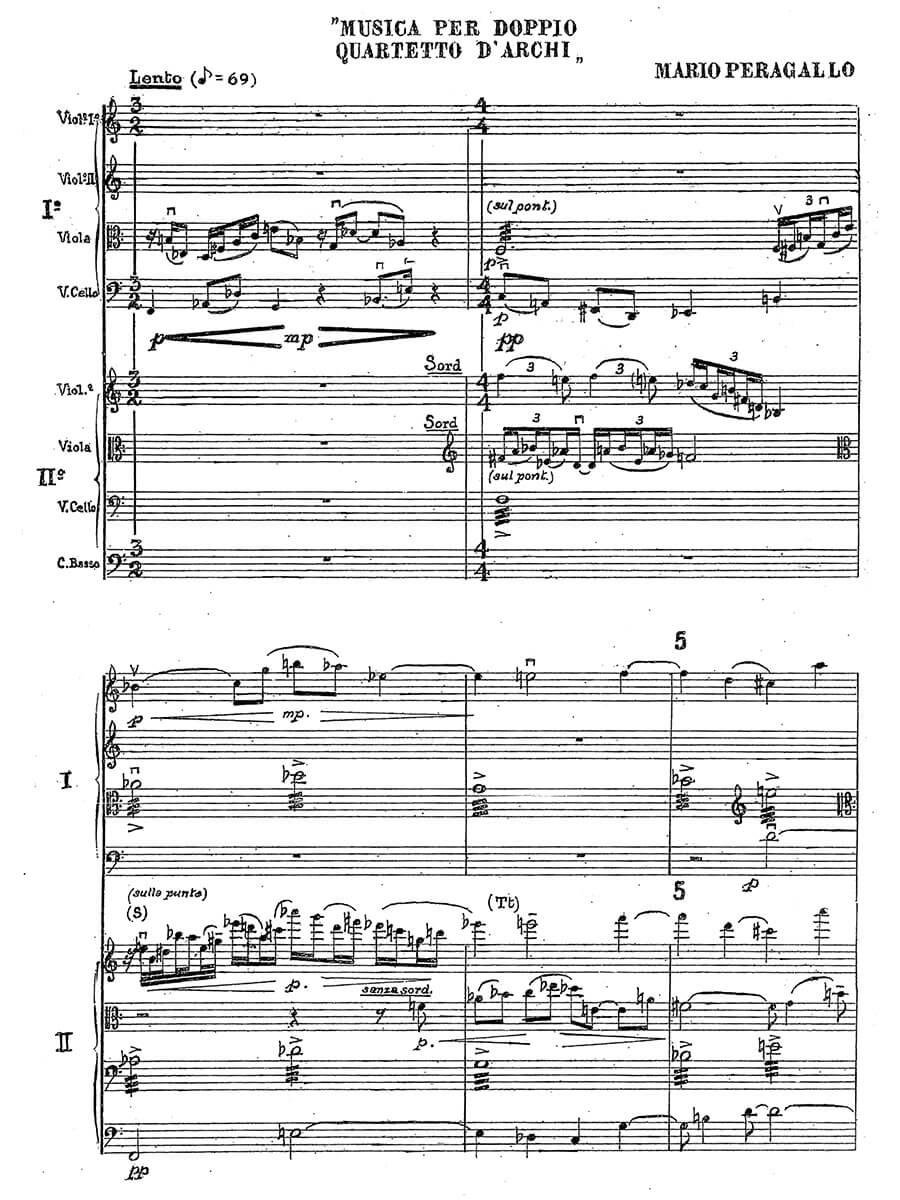Musica per doppio quartetto d’archi
Peragallo, Mario
21,00 €
Preface
Mario Peragallo – Musica per doppio quartetto d’archi
(b. Rome, March 25, 1910 – d. Rome, November 23, 1996)
Lento
Allegro (ben ritmato)
Andante
Allegro molto
Allegretto (Fuga)
(First performed under the aegis of the Accademia Filarmonica Romana at the Teatro Eliseo, Rome,
on 19th April 1948)
Preface
Mario Peragallo was born in Rome to Genoese parents, Cornelio, a successful businessman, and his wife Matilde. Both parents were keen lovers of music, and Cornelio would become the president of the Accademia Filarmonica Romana from 1944 till 1950. Mario studied composition with Vincenzo di Donato, and piano with Francesco Baiardi. Di Donato, a major figure in Roman musical life at this time, produced editions of music by up-and-coming composers under the title Collezione Dorica, and Peragallo quickly distinguished himself in this ‘Doric’ circle. He made his debut with the Adagio per orchestra d’archi e arpa, performed during the Accademia Filarmonica’s 1925-6 season. Other works were published in Dorica, and in its successor La Rassegna Musicale (founded by di Donato in 1929). Peragallo achieved fame initially in the operatic milieu. Working with the eminent librettist Giovacchino Forzano, his Ginevra degli Almieri (1937) and Lo Stendardo di San Giorgio (1941) met with public – if not always critical – approbation. The war years coincided with changes in the personal and artistic life of our composer. He married Fiora Ginanni in 1943 and they had three children. After a creative silence of some five years, Peragallo entered a second phase of his career, producing works that explored a more chromatically saturated palette, and then moving on to a personal version of dodecaphony. The first fruit of this new serial direction was the ‘madrigale scenico’ La Collina which excited great interest at the contemporary music festival in Venice in 1947. In the same year he organized a tour to nine Italian cities of Schoenberg’s Ode to Napoleon Bonaparte and Pierrot Lunaire, this bringing back memories of the well-nigh legendary Pierrot tour organized by Casella’s Corporazione delle Nuove Musiche in 1924. Peragallo continued along the 12-note path in instrumental pieces: Musica per doppio quartetto d’archi (1948), Concerto per pianoforte e orchestra (1949), Fantasia per orchestra (1950), and most importantly the Concerto per violino e orchestra (1953-4). Towards the end of the 1950s he allied himself stylistically with the techniques of the younger generation of composers in Forme sovrapposte per orchestra (1959), and, inspired – as many composers were – by the virtuosity of the flautist Severino Gazzelloni, in Vibrazioni per flauto, piano e tiptofono (1960). This compositional itinerary is comparable to that of Petrassi (1904-2003), who used serialism in several of his Concerti per orchestra in the 1950s and then blended himself into the sound worlds of Berio, Castiglioni and Donatoni in the 1960s. The comparison breaks down after that: Peragallo was an extraordinarily zealous administrator and innovator in his many years as president of the Società Italiana di Musica Contemporanea (1956-60, 1963-86). However this organizational activity took its toll: unlike the consistently productive Petrassi, Peragallo experienced a 20-year compositional drought, only to be broken in 1980 with Emircal (for orchestra and tape). Emircal (‘Lacrime’ backwards) was written on a wave of emotion at the death of his friend of many years, Luigi Dallapiccola. Peragallo became a widower in 1979, but remarried ten years later to Anna Cudin. He died in 1996. …
Full preface / Komplettes Vorwort > HERE
Score Data
| Edition | Repertoire Explorer |
|---|---|
| Genre | Chamber Music |
| Size | 210 x 297 mm |
| Printing | Reprint |
| Pages | 54 |
